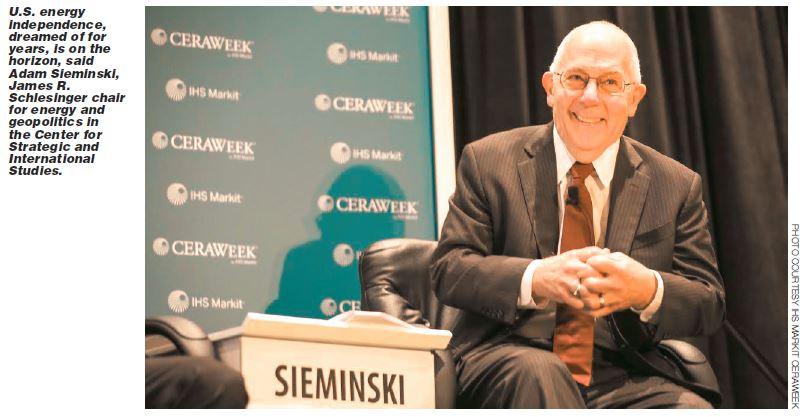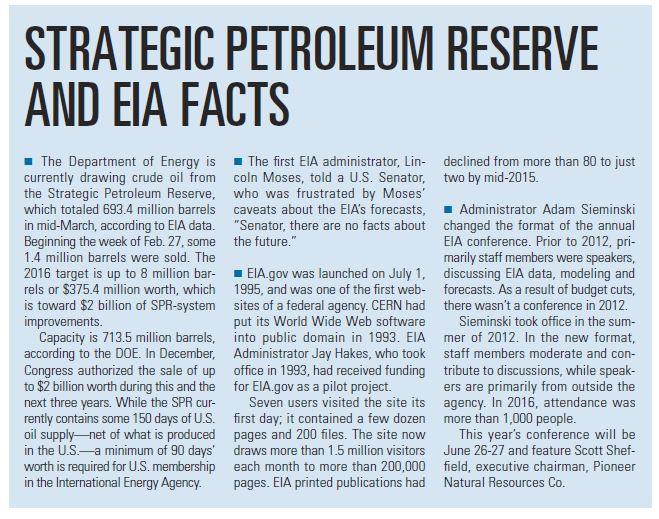
When one is tapped to be nominated to head the U.S. Energy Information Administration, is there a phone call followed by a caravan of dark SUVs, Secret Service agents and back-door entry to the White House? “No, no, no. It was nothing like that,” Adam Sieminski said, laughing. “You have to fill out a lot of forms. A lot of forms.”
This was in early 2012 as Sieminski was retiring as Deutsche Bank’s chief energy economist, and EIA administrator Richard Newell was stepping down. Sieminski said that, as he understands it, Department of Energy Secretary Steven Chu asked Newell for a short list of possible replacements. “My name was on that list.”
Sieminski received the call from Newell. Did he want to be considered? “I said, ‘Yes—but please check first to see if they are okay with somebody from Wall Street!’” Several interviews, including with Secretary Chu, followed; there was a Senate hearing. He was confirmed.
Taking office on June 4, 2012, Sieminski’s first major task was soon apparent: A fundamental change in how the EIA prepares its annual energy outlook. The 2013 edition was due in about six months. And the U.S.’ oil and gas profile was rapidly changing.
Pipelines, fracture stimulation
But first, does Sieminski—who served in the Obama administration—support more oil, natural gas and product pipelines? Yes.
“Pipelines were shown by the EPA to be one of the safest modes of transportation for crude oil and petroleum products,” he said. “Better than trains, better than trucks, better than tankers, better than barges. You have spills from pipelines occasionally; we have rules in place to minimize that and deal with the aftermath.”
As U.S. energy consumption—particularly of natural gas and NGL—continues to grow, “we are still going to need infrastructure. We have to build facilities to move production from new areas—like oil in North Dakota or natural gas in Pennsylvania—to where consumers need it.”
And Sieminski’s thoughts on hydraulic fracturing? U.S. Senator Bernie Sanders, during his presidential bid, said he wanted to ban it. But, Sieminski said, “with half of our oil and gas coming from fracturing, it didn’t seem like a very practical idea to ban it.
This year is the 70th anniversary of hydraulic fracturing. In 1947, Stanolind Oil & Gas Corp. called Halliburton Co. to fix a well in Kansas. Introducing water seemed counter-intuitive, but the well wasn’t going to work as it was anyway. The water-based stimulation did work. Halliburton patented it and rolled it out in Oklahoma and Texas in 1949.
“Yeah, it’s been around a long time.” The EPA concluded in its recent studies, he said, that “it didn’t seem to be a problem. And this was the EPA; not an industry group.” Sieminski served under both Chu and, after Chu left in 2013, Secretary Ernest Moniz. “Secretaries Moniz and Chu had it figured out, which is that every energy source has problems of some type, but we need energy, so we have to learn to manage the problems.
“A lot of hydraulic fracturing is under state regulations and states have a pretty strong interest in making sure groundwater isn’t polluted. Whether it’s Texas, Oklahoma, North Dakota, Pennsylvania or anywhere else, they’re pretty careful about it.”

Missing the numbers
Given new U.S. oil and gas supply from tight rock, Sieminski knew that how the EIA developed its annual energy outlook needed to be revised. Preliminary results were released in December 2012.
“By January, the U.S. oil-production numbers were already a half-million barrels a day too low in the preliminary data.
“So I called everyone together. I said, ‘If you’re going to be in the forecasting business, you’re going to be wrong; hopefully, not all of the time.’ I was on Wall Street for a lot of years and I had plenty of forecasts that were wrong. But I tried really hard to not be wrong right away.”
He asked the staff to look at the modeling “and tell me why we had this problem so quickly. The answer came back that there were some modeling issues, but terrible lags in the actual reporting of production data.”
In Jan. 2014, while Continental Resources Inc. chairman and chief executive Harold Hamm was testifying in a Senate hearing on exporting U.S. oil, he said that the EIA didn’t “get” the tight-oil phenomenon and its numbers had been “totally distorted.”
“We had to teach them how to count,” Hamm said. “At one time, they were only taking the crude oil numbers and not putting any of the [NGL] in. Once they did that, they finally realized that we’re up to about 12.6 million barrels a day of production in this country.”
Sieminski said that the forecast in the January 2013 report was based on data from 2011. That may have worked fine prior to 2012: Daily U.S. oil production since 1999 had been in the doldrums at about 5 million barrels per day (MMbbl/d)—or less, when production was offline due to Gulf of Mexico hurricanes.
In December of 2011, however, the number started with a 6; by the end of 2012, with a 7. “Production was ramping up very rapidly,” Sieminski said. “We just completely missed it.”
How to fix that? A staffer, Jozef Lieskovsky, raised his hand. “He said, ‘I’ve been working on a report that will give us a better idea of what current production is so we can know what production is this month rather than a year ago.’”
That spawned the EIA’s now-popular Drilling Productivity Report. Lieskovsky also found that the DPR was insufficient because it didn’t account for the potential implications of DUCs—drilled, but uncompleted, wells—on U.S. production fluctuation. That spawned the DUC count.
Overall, these “dramatically improved the accuracy of the EIA’s near-term production forecast that we were using as the starting point for the annual energy outlook. The DUC study and the DPR made the EIA data much more timely and relevant to what policymakers were trying to understand: What’s going on with shale and what does it mean?”
For example, the EIA wasn’t directly collecting early production data from North Dakota and Pennsylvania. “I said, ‘That’s got to be changed.’”
Real-time data
Making EIA data more timely and useful were key to Sieminski’s goals for the agency. He had used the data in his work on Wall Street. Heading the EIA itself was certainly “like a dream job. I spent my career as an energy analyst being a voracious consumer of EIA data and analysis and I got the job of running it.
“I had an idea of what needed to be done differently.”
One idea was to make the EIA more timely. “In one of the first talks I gave to the assembled staff in the auditorium, I said, ‘If you just do a graph where the y-axis is the number of products the EIA has and the x-axis represents a time scale, starting with historical data going out into future forecasts, what it looked like was kind of a saddle—a V or a U.’”
The low point was what was happening in real time—“I said, ‘We have to be more focused on what’s happening right now in energy.’ I began to use the phrase ‘Energy Now.’
“I wanted to know what’s happening this week, last week, next week, this month, next month that would be important to analysts, policymakers and anyone else. We flattened the product slate a bit.”
Something that was in beta test at press time that Sieminski initiated is data on U.S. power generation on an hourly basis. “It is virtually in real time. It’s 11:16 a.m. right now. In about five minutes, they will have data for between 9:00 and 10:00 this morning.”
The data are from existing real-time sweeps conducted by regional agencies. “It just wasn’t being aggregated into national data,” Sieminski said. His plan for the power gen report next is to include real-time data on the myriad fuel sources—natural gas, coal, solar, hydro—in U.S. power generation. “That is going to be hugely valuable to researchers and policymakers to understand the contribution that different fuels make on an hour-to-hour basis in meeting electricity demand in the United States.”
The EIA is also working with the Groundwater Protection Council on well-by-well data on produced-water rates and reinjection. And it is evolving how it surveys industry and institutions in its data sweeps.
“We were working on using off-the-shelf software to make it easier for respondents to provide the data and easier for us to collect it, check it, bring it together and present it to the public. That’s something that started before I got to the EIA and I’m certain it’s something that will continue with the next administrator.”
The “Ask an Expert” feature at the EIA website pre-dated him. The write-in box appears at the bottom of a page after a site visitor has searched for, for example, “How much oil is consumed in the United States?” and isn’t convinced by the answer. Oftentimes, the answer is provided by a staff member the same day. “There are so many dedicated people at the EIA—and they’re smart.”
How many barrels of crude oil does the U.S. really consume net of exports? Sieminski prefaced his answer with the technicalities of actual consumption and “refinery gains.” But, in short, the U.S. still uses more crude oil domestically than it produces, although it is a net exporter of oil products.
“But one of the scenarios in the 2017 annual energy outlook was that—in the high technology case and the high resource case— the U.S. could actually be a net exporter of crude oil in the next decade.
“Energy independence had been the dream of how many U.S. presidents going back for decades—and we’re almost there!”
 North American exports
North American exports
In February 2009, Fed chairman Alan Greenspan spoke at the annual IHS CERAWeek conference, telling CERA co-founder Daniel Yergin that he saw nuclear as the source of future growth in U.S. power supply. Sieminski told Investor he would have said the same at the time.
He was on the National Petroleum Council in 2006 and 2007 during the George W. Bush administration when the NPC published its “Facing the Hard Truths about Energy” report.
“Shale was mentioned as a possible source, but it was thought to be too expensive to really work from an economic standpoint.
“Ten years ago, everybody thought we would be importing LNG, we would have a nuclear renaissance, we were running out of oil and gas domestically, and we would be facing ‘Gas OPEC.’
“Remember the [talk of a] Gas OPEC? Ten years later, that’s been turned upside down. By 2010, it was getting pretty clear that shale was going to be really different.
“That’s probably a good lesson to anybody who does long-term forecasting: Expect to be surprised. By the end of this year and into 2018, we will be net exporters of natural gas.”
The DOE’s approval was required to export U.S. gas to non-Free Trade Agreement countries, which are most countries. It consulted the EIA on the implications on prices and supply.
“They needed to know how much natural gas would be available if they allowed these exports. People were saying it would kill the chemical industry and consumers would pay significantly higher prices.
“But the EIA found that wasn’t true. Our conclusion was that allowing LNG exports would probably result in a relatively small increase in prices in the U.S. and have net positive economic benefits.”
The EIA was soon asked the same questions about crude oil. Export of U.S. oil had been permitted since 1977 only by presidential exception. In 2015, when Congress was considering repealing the law to allow unrestricted export, “there were people who were claiming it would make gasoline prices go up in the U.S. by a significant amount,” Sieminski said.
“Our conclusion was that it probably didn’t do much to gasoline prices and, if it did, it would probably go down a few pennies.” More oil on the international market would lower the price of Brent, which could lower the price to the U.S. East and West coasts.
Sieminski cited the EIA’s work on analyzing the effect of both natural gas and crude oil exports as full-circle examples of why the EIA was created in 1977—to provide facts regarding U.S. energy supply and prices.
“That’s exactly what both the Republicans and the Democrats back in the late 1970s had in mind: An independent agency that could provide data and analyses on energy so that, when policies do get crafted, they are based on fact.”
An exogenous event during Sieminski’s term was another “whoa” moment: Mexico de-nationalized some of its oil and gas reserves. The change required an amendment to its constitution. Nationalization had been in effect since 1938.
“It was an incredible turn-around when you think of it in Mexican terms,” Sieminski said. “They had a constitutional provision that you couldn’t have foreign ownership in Mexico in the energy area. “It was a low moment [in Mexico’s energy history], but it was also a congratulatory moment in that the Mexicans are finally coming around to understanding that the path they were on was not sustainable. So they changed it.
“They have set themselves up for several decades of growth. And that they have continued to hold fast to the reforms despite the drop in oil prices is pretty interesting.”
In Sieminski’s time in the EIA, there was also that peculiar event in late 2014 when OPEC members decided they wouldn’t balance world oil supply. While they continue to scramble to respond to the growth in U.S. production—from 5.5 MM-bbld/ in January of 2011 to 9.6 million in April 2015 and holding up at 9.1 million in mid-March—is North America becoming an energy powerhouse?
“You’re right,” Sieminski said. “If you take the U.S., Mexico and Canada together, we are energy independent. You’re still in a global market and, if prices go up, it affects everybody. That can be an issue, but the positive impact on the economy for most people in North America is pretty strong.
The positive aspects of trade we are engaged in with Mexico and Canada are pretty helpful to consumers and the economy, and, ultimately, I think those facts are going to weigh on both the White House and Congress.”
Hard copy club
Sieminski holds the James R. Schlesinger Chair for Energy and Geopolitics in the Center for Strategic and International Studies in Washington, D.C. He’s in the “hard-copy club.” There are three people who get a hard copy of the EIA’s Monthly Energy Review: “Dan Yergin loves his and Alan Greenspan still gets one—and now me. It’s great to be able to thumb through it—and then, go to EIA.gov to download the data.”
Schlesinger was the first U.S. energy secretary, heading the department upon its formation in 1977. He was also the keynote speaker in the inaugural annual meeting in 1979 of what became the International Association for Energy Economics.
Sieminski was president of the U.S. Association for Energy Economics and of the National Association of Petroleum Investment Analysts. In addition, he was chairman of the IPAA’s Supply-Demand Committee and a member of the Strategic Energy Task Force of the Council on Foreign Relations.
While he worked in the private sector until his EIA appointment, he had always had an interest in public service. From Cornell, he had received his undergraduate degree in civil engineering and a master’s in public administration.
“But then, I got involved in Wall Street research and became a Wall Street analyst. I joke that, after so many years, I finally got to put my graduate degree to work.”
The summer of his confirmation, he visited his home town, Williamsport, in Lycoming County, Pennsylvania. His brother-in-law, a pilot, flew him over the Marcellus play.
“You could see the shale-gas pads being developed. I remember coming back from that saying, ‘My God, this is going to be huge. Enormous!’ ‘Game-changer’ was the word a lot of people used. That’s when I knew the 2013 energy out-look needed to be revised.”
One energy-securities analyst was frustrated in March by monthly DOE data on product demand that had been significantly revised from the weekly data. Sieminski said, “I understand the frustration that analysts feel when the numbers change. I was a financial analyst for most of my career.” But data reporting and collection “are not perfect and it’s better to revise the figures to reflect the facts as soon as you know about it.”
He added, “EIA’s reputation as an energy agency is the envy of virtually every country I’ve been in—and I’ve traveled a lot.”
A new EIA administrator had not been named yet at press time. Sieminski said, “I’m going to be wishing all the luck in the world to whoever that is. Republican, Democrat, independent—it doesn’t matter.”
Recommended Reading
Exclusive: Mesa Minerals IV to Reload in Haynesville, Permian, Other Basins
2025-03-19 - Mesa Minerals IV, backed by NGP funds, is launching to acquire mineral and royalty interests in the Permian and Haynesville, said Mesa President and CEO Darin Zanovich at DUG Gas.
TG Natural Resources Boasts 20 Years of Haynesville Inventory
2025-04-09 - TG Natural Resources President and CEO Craig Jarchow said the company’s valuable Haynesville inventory provides a line of sight for investors 20 years down the line.
Queen’s Chess: Changing the Rules
2025-02-28 - There’s a popular response to the inexplicable: “I don’t know. I don’t make the rules.” But what is known with certainty, as shown throughout history, is that we can change them.
Comments
Add new comment
This conversation is moderated according to Hart Energy community rules. Please read the rules before joining the discussion. If you’re experiencing any technical problems, please contact our customer care team.




